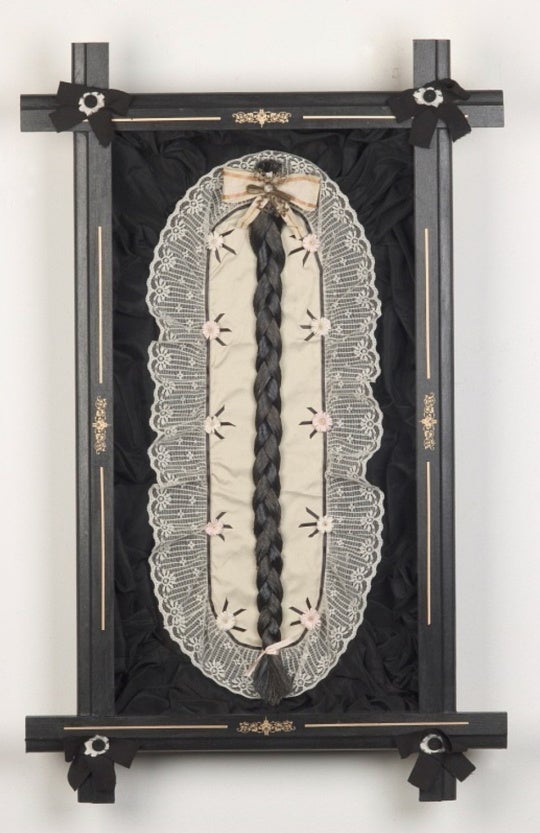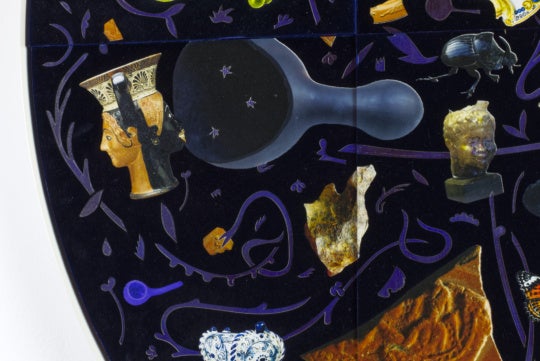
Viewing the work of Marcus Kenney is similar to driving along a meandering back road in the South, where perhaps a Pentecostal church with a sign warning us of our imminent exit to hell gives way to a roadside stand promising the freshest citrus (“Free Samples!”), and where kudzu-and-rust covered trailers abandoned in overgrown lots like corpses on a battlefield stand cheek-by-jowl with multimillion-dollar tract homes in gated communities with proudly insensitive names like “The Plantation.”
Through his 2-D work, assemblages, and installations, Savannah-based Marcus Kenney is a de facto fabulist of this realm, threading together all of the weird energies of staid tradition and, at times, reluctant evolution of the contemporary American South. Kenney’s latest exhibition, “Dope,” features recent examples of the artist’s undeniable skill in surveying the cultural, political, and even spiritual climates of the South.

The 31 pieces in “Dope” are spread throughout Florida Mining Gallery, which is adjacent to the front, lobby area of the Harbinger Sign building on the Southside of Jacksonville. The gallery is owned by artist Steve Williams, who is also the CEO of the family-owned, multimillion-dollar corporation. Oddly enough, the experience of walking into a contemporary gallery space that flows into a busy office environment makes Kenney’s art even more impactful.

The real meat of the show is in the main gallery. While hardly crowded, Kenney makes good use of the given area. Three oil corroded canisters, (Dirt, Seed, and Water) are painted red, white, and black, each emblazoned with a dollar sign, which could point to a blunt commentary on independent farming versus complex agri-business commodities. Within feet of this rusty triptych, sits the Anti Confederate Flag Cooler, a kind of anti-commercial for possible football-and-beer-drenched xenophobia, accompanied by Anti Confederate Flag on a nearby wall.
Taking its title from a pivotal scene in Fellini’s 1963 film, 8½, Asa Nisi Masa dominates the east wall of the gallery. The large netlike piece drapes down the white wall onto the hardwood floor, a cartoon-like smiling face doing little to offset the object’s invasive sense of menace. On the opposing wall, a 2D companion piece with the same title mutates that happy expression into one of sheer dread.

Many of the figures populating Kenney’s assemblages have the quality of effigies. In Early Moon (Old Man Coyote) an African-American rag doll in a gingham dress wears a heart as a crown, printed “I Love You.” At first, it appears that the bloodied, injured wolf she is riding under the moonlight is taking her to freedom, until we see that the beaten wolf is tethered to a rope.
Kenney is known for his loaded political messages and they are well represented in “Dope.” The piece Peanuts features a young boy painted an almost obsidian black, decked out in camouflage as an inverted US flag hangs overhead. Old Glory is also reexamined in the large-scale Old Friends 4 Sale, with its inverted, vertical flag seeming to nestle a garish, gold bag of money.

However, the strongest offerings in “Dope” are two large pieces that seem to stare at one another from opposing gallery walls. A kind of colorized fever dream of ribbons, shreds of cloth, and stuffed-doll limbs, Generals Without Armies features a deranged, rag doll angel clutching a portrait of some staid relative under its arm. This piece of cryptic USA is countered by Eyeno. If there is a single piece in “Dope” that demands repeated scrutiny, it is Eyeno. For years, Kenney has been creating byzantine pieces featuring animal heads and skulls sprouting dizzying colors and contrasting materials. Evoking a Native American vision, a classical medusa, ceremonial magick and a folk art sigil, Eyeno is Kenney deep into his environment, a testament to unfiltered imaginative thought and an almost subconscious choosing of media.
The contemporary South remains a literal place of the sacred and the profane. For every bible college, state park and Civil War site there is a pawnshop, strip club and pill mill open 24/7. Kenney is hardly commenting on the South as visitor or passerby. This is his tribe and he its indigenous artist. Looking at the myriad pieces in “Dope,” his criticism, fascination, repulsion and absolute affection for the South are evident. The South seems both blessed and cursed by tradition. The Confederate flag has become a Mark of Cain, protecting unseen figures behind dark windows of monster pickup trucks.
Kenney’s genius lies in his ability to tear into regional tradition, folklore and even pop culture, digging out layers of new ideas and heady, visual translations. His strengths kick in when he welds those emotions and thought processes into one, using media in such a malleable way that we are left with the proverbial sense of place, people and ideas. Kenney pushes these genetic signifiers into creating a celebration of community that is simultaneously familiar and alien, if not terrifying.
“Dope” is on view through March 20 at Florida Mining Gallery in Jacksonville.
Daniel A. Brown is a musician, writer, and editor living in Jacksonville, Florida. A onetime bassist for Royal Trux and ’68 Comeback, Brown is the arts and entertainment editor for Folio Weekly. Brown has written for DownBeat Magazine, Cartwheel Art, Aesthetica and American Airline’s American Way Magazine. In addition, Brown maintains an arts site called Starehouse (starehouse.com), which profiles Northeast Florida, national and international artists.




